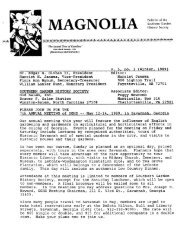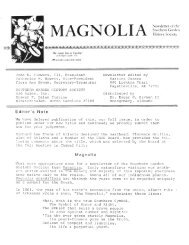- Page 1: Southern Plant Lists Southern Garde
- Page 5 and 6: Page Date State List Name Henry 74
- Page 7 and 8: Brothers of the Spade Correspondenc
- Page 9 and 10: Plants sent to Custis by Collinson
- Page 11 and 12: Custis and Collinson Virgina 1734-1
- Page 13 and 14: Cauliflower Chives Artichokes Radis
- Page 15 and 16: Sunflowers Tulips Moccasin flower T
- Page 17 and 18: Fall harvest apple Winter queening
- Page 19 and 20: Virginia Gazette Williamsburg, Sept
- Page 21 and 22: Brother Lung 1759 North Carolina
- Page 23 and 24: Melissa officinalis Balm Mentha aqu
- Page 25 and 26: Thomas Jefferson’s Plant List Fro
- Page 27 and 28: Thomas Jefferson 1767-1821 Virginia
- Page 29 and 30: Ornamental Shrubs and Vines Thomas
- Page 31 and 32: Thomas Jefferson 1767-1821 Virginia
- Page 33 and 34: Thomas Jefferson 1767-1821 Virginia
- Page 35 and 36: Thomas Jefferson 1767-1821 Virginia
- Page 37 and 38: Thomas Jefferson 1767-1821 Virginia
- Page 39 and 40: Thomas Jefferson 1767-1821 Virginia
- Page 41 and 42: Beet "Haricots" Lima Bean Scarlet R
- Page 43 and 44: Thomas Jefferson 1767-1821 Virginia
- Page 45 and 46: Melon Thomas Jefferson 1767-1821 Vi
- Page 47 and 48: Pisum sativum var. arvense Peanut (
- Page 49 and 50: Sweet Potato Thomas Jefferson 1767-
- Page 51 and 52: Heath (White Heath) Large White Cli
- Page 53 and 54:
Peter Crouwells 1786 Pennsylvania H
- Page 55 and 56:
Wallflower Erysimum cheiri Crown Im
- Page 57 and 58:
Virginia Gazette and Richmond Daily
- Page 59 and 60:
Virginia Gazette and Richmond Daily
- Page 61 and 62:
FLOWERS ROOTS Red, White, & Blue Hy
- Page 63 and 64:
Lady Jean Skipwith 1793 Virginia bl
- Page 65 and 66:
Dodecatheon meadia Shooting Star(fo
- Page 67 and 68:
Lady Jean Skipwith 1793 Virginia Li
- Page 69 and 70:
Lady Jean Skipwith 1793 Virginia an
- Page 71 and 72:
Virginia Gazette and General Advert
- Page 73 and 74:
The Virginia Herald Fredericksburg,
- Page 75 and 76:
Prussian blue [P. sativum ‘Prussi
- Page 77 and 78:
Governor Henry Middleton 1800 South
- Page 79 and 80:
Henry Middleton’s Seed and Plant
- Page 81 and 82:
Blue-spiked Speedwell Veronica Spic
- Page 83 and 84:
1802 Seed Catalog Bernard McMahon P
- Page 85 and 86:
Anemone Hepatica Hepatica Anemone h
- Page 87 and 88:
Brassica capitata ‘Early Russia
- Page 89 and 90:
Carpinus betulus vulgaris Hornbeam
- Page 91 and 92:
Cucumis Melo Black Rock Melon Cucum
- Page 93 and 94:
Ervum lens Lentils Erythronium Dens
- Page 95 and 96:
Lactuca sativa Early Forcing Coss L
- Page 97 and 98:
Mirabilis Jalapa Purple Striped Mar
- Page 99 and 100:
Pinus inopa Jersey Pine Pinus Larix
- Page 101 and 102:
Salvia violacea Purple Clary Sangui
- Page 103 and 104:
Veronica virginiana Veronica, Speed
- Page 105 and 106:
The Virginia Argus New Kent County,
- Page 107 and 108:
Tricolor Amaranthus Amaranthus tric
- Page 109 and 110:
Large Norfolk Field Turnep Brassica
- Page 111 and 112:
Blue Con. Minor Convovulus Convolvu
- Page 113 and 114:
Franklinia Franklinia alatamaha Car
- Page 115 and 116:
Curled Cress Lepidium crispum Broad
- Page 117 and 118:
Dwarf Dutch Beans Phaseolus vulgari
- Page 119 and 120:
Garden Sorrel Rumex Acetosa French
- Page 121 and 122:
Lisbon Vines Vitis Muscat of Alexan
- Page 123 and 124:
Beets Borecole or Kale Brocoli Burn
- Page 125 and 126:
Cucumbers Eggplant Endive Eschalot
- Page 127 and 128:
Parsley Parsnip Pea Lady pea Indian
- Page 129 and 130:
Savory, summer and winter Thyme, up
- Page 131 and 132:
Black redstricke Herfordshire redst
- Page 133 and 134:
Apples for making Cyder Appricot tr
- Page 135 and 136:
Grapes for wine, vitis vinifera Med
- Page 137 and 138:
Pear-tree, Pyrus Royal Charlotta Dr
- Page 139 and 140:
Quince-tree, Pyrus Cydonia Raspberr
- Page 141 and 142:
Convolvulus Hawkweed Hedgehog, Tref
- Page 143 and 144:
Xeranthemum Yellow Toad flax, Antir
- Page 145 and 146:
Crocus Delphinium Dianthus, Pink Fr
- Page 147 and 148:
Lathyrus Narcissus or daffodil Orni
- Page 149 and 150:
Amygdalus-persica, duplex Andromeda
- Page 151 and 152:
Dirca Epigaea Euonymus Fraxinus Fra
- Page 153 and 154:
Lycium Magnolia Mespilus Myrica Phi
- Page 155 and 156:
Rubus odoratus Salix Spartium Spira
- Page 157 and 158:
GREEN HOUSE AND STOVE PLANTS GENERI
- Page 159 and 160:
pulcherrima Variegated flowers elat
- Page 161 and 162:
Dracaena Dracaema, female dragon te
- Page 163 and 164:
pumila Dwarf Malphighia Barbados ch
- Page 165 and 166:
capitatum Rose-scented cucullatum H
- Page 167 and 168:
Norway maple [Acer platanoides] Ken
- Page 169 and 170:
White Cranberry Dwarf Phaseolus vul
- Page 171 and 172:
Leek Large Scotch Allium porrum Lon
- Page 173 and 174:
Yellow Swedish, or Ruta Baga Brassi
- Page 175 and 176:
Field Peas, white and green Pilum s
- Page 177 and 178:
Early cauliflower [Brassica olerace
- Page 179 and 180:
Owens and Leckie 1826 Virginia Myrt
- Page 181 and 182:
The American Farmer, Vol. 9, 1827 B
- Page 183 and 184:
Mrs. Tripp’s Flowers and Herbs Be
- Page 185 and 186:
Oenothera pink primrose Osmunda cin
- Page 187 and 188:
(From Southern Agriculturist) sweet
- Page 189 and 190:
Genus and Species Common Name Acer
- Page 191 and 192:
Lythrum hyssopifolium loosestrife M
- Page 193 and 194:
Plants Grown by Jacob Smith, 1844-1
- Page 195 and 196:
Jacob Smith 1844-1859 Arkansas Colc
- Page 197 and 198:
Jacob Smith 1844-1859 Arkansas Hyac
- Page 199 and 200:
Jacob Smith 1844-1859 Arkansas Malu
- Page 201 and 202:
Jacob Smith 1844-1859 Arkansas Ranu
- Page 203 and 204:
Jacob Smith 1844-1859 Arkansas Rosa
- Page 205 and 206:
Plants in Hannah Knight’s Garden
- Page 207 and 208:
Miss Betty Roper’s Herbarium 1853
- Page 209 and 210:
Liriodendron tulipifera yellow-popl
- Page 211 and 212:
Pyrus Japonica (Quince) Pecan Plum
- Page 213 and 214:
Datura stramonium Jimsonweed Decuma
- Page 215 and 216:
Thaspium chapmanii Thaspium Tilia h
- Page 217 and 218:
Apples Terms invariably, CASH, or C
- Page 219 and 220:
Pippin - Holland Pippin - King of P
- Page 221 and 222:
De Colmar Dix’s Rareripe Early Pu
- Page 223 and 224:
De Spoelberg De Tongres De Sorlis D
- Page 225 and 226:
Mulberries Cloud English Everbearin
- Page 227 and 228:
Rose Garden - Gowrie Plantation, Ar
- Page 229 and 230:
Holly, small leaved; Ilex vomitaria
- Page 231 and 232:
Montgomery Nurseries Montgomery, Al
- Page 233 and 234:
Blanche Lafitte " de Meru Maria Boi
- Page 235 and 236:
Peerless Prince de Salm Rev. H. Dom
- Page 237 and 238:
Fruits, Flowers And Vegetables Mrs.
- Page 239 and 240:
Included loosely in back of book ar
- Page 241 and 242:
Lavinia Roberts 1885 North Carolina
- Page 243 and 244:
Phloxes, Giant perennial Platycodon
- Page 245 and 246:
Philadelphia Rambler Pink Rambler P
- Page 247 and 248:
President Cleveland, Climbing R. M.
- Page 249 and 250:
Azalea arborescens [Rhododendron ar
- Page 251 and 252:
Gelsemium carolinianum [G. sempervi
- Page 253 and 254:
Monarda sp. Wild bergamot Morus alb
- Page 255 and 256:
Rosa sp. ‘Firefly’ Rose Rosa sp
- Page 257 and 258:
Viburnum opulus ‘Sterile' [V. opu
- Page 259 and 260:
Dorothy Perkins, Red Dr. W. Van Fle
- Page 261 and 262:
Reine Marie Henriette Reve d'Or Rhe
- Page 263 and 264:
Lady Hillingden (Tea, 1910) Louis P
- Page 265:
Senator Mascarend Sir Thomas Lipton

















